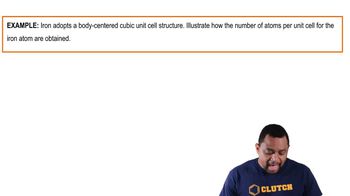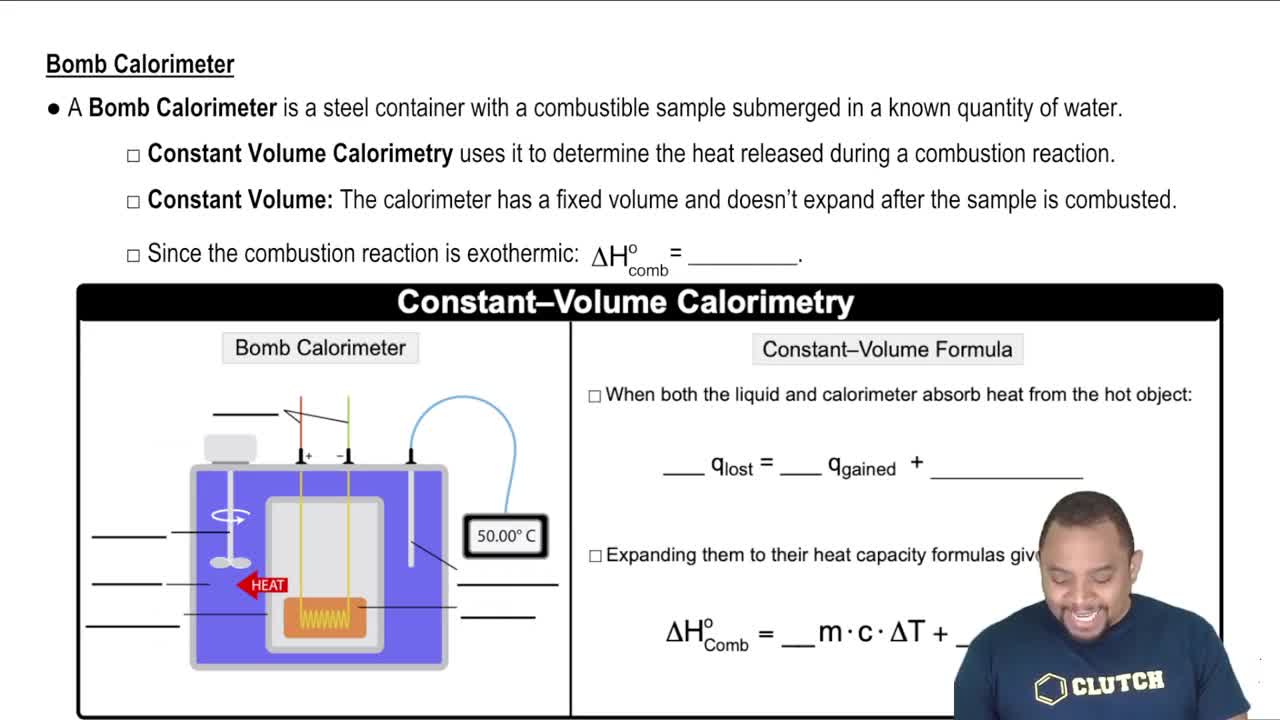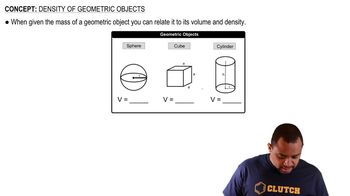The density of an unknown metal is 12.3 g/cm3, and its atomic radius is 0.134 nm. It has a face-centered cubic lattice. Find the atomic mass of this metal
Ch.13 - Solids & Modern Materials

Chapter 13, Problem 84
When spheres of radius r are packed in a body-centered cubic arrangement, they occupy 68.0% of the available volume. Use the fraction of occupied volume to calculate the value of a, the length of the edge of the cube, in terms of r.
 Verified step by step guidance
Verified step by step guidance1
Understand that in a body-centered cubic (BCC) arrangement, there is one atom at each corner of the cube and one atom in the center.
Recognize that the volume occupied by the spheres is 68.0% of the total volume of the cube.
The volume of a single sphere is given by \( \frac{4}{3} \pi r^3 \). In a BCC unit cell, there are effectively 2 spheres (1/8 of a sphere at each of the 8 corners and 1 whole sphere in the center).
The total volume of the cube is \( a^3 \), where \( a \) is the edge length of the cube.
Set up the equation for the fraction of occupied volume: \( \frac{2 \times \frac{4}{3} \pi r^3}{a^3} = 0.68 \) and solve for \( a \) in terms of \( r \).
Key Concepts
Here are the essential concepts you must grasp in order to answer the question correctly.
Body-Centered Cubic (BCC) Structure
The body-centered cubic (BCC) structure is a type of crystal lattice where atoms are located at each corner of a cube and a single atom is positioned at the center of the cube. In this arrangement, each unit cell contains two atoms, one from the corners and one from the center. Understanding this structure is essential for calculating the volume occupied by the spheres and how they relate to the edge length of the cube.
Recommended video:
Guided course

Body Centered Cubic Example
Volume Occupancy
Volume occupancy refers to the fraction of space within a given volume that is filled by particles, in this case, spheres. In the BCC arrangement, it is given that the spheres occupy 68.0% of the available volume. This concept is crucial for determining how the radius of the spheres relates to the edge length of the cube, as it allows for the calculation of the total volume occupied by the spheres in relation to the cube's volume.
Recommended video:
Guided course

Constant-Volume Calorimetry
Geometric Relationships
Geometric relationships in three-dimensional space are fundamental for relating the radius of the spheres to the edge length of the cube. In a BCC structure, the diagonal of the cube can be expressed in terms of the radius of the spheres. By applying the Pythagorean theorem, one can derive the relationship between the edge length 'a' and the radius 'r', which is necessary for solving the problem.
Recommended video:
Guided course

Density of Geometric Objects
Related Practice
Textbook Question
Textbook Question
An unknown metal is found to have a density of 7.8748 g/cm3 and to crystallize in a body-centered cubic lattice. The edge of the unit cell is 0.28664 nm. Calculate the atomic mass of the metal.
1
views
Textbook Question
Calculate the fraction of empty space in cubic closest packing to five significant figures.
Textbook Question
X-ray diffractometers often use metals that have had their core electrons excited as a source of X-rays. Consider the 2p → 1s transition for copper, which is called the K⍺ transition. Calculate the wavelength of X-rays (in Å) given off by the K⍺ transition if the energy given off by a mole of copper atoms is 7.77⨉105 kJ.(1Å = 10-10 m)
1
views
